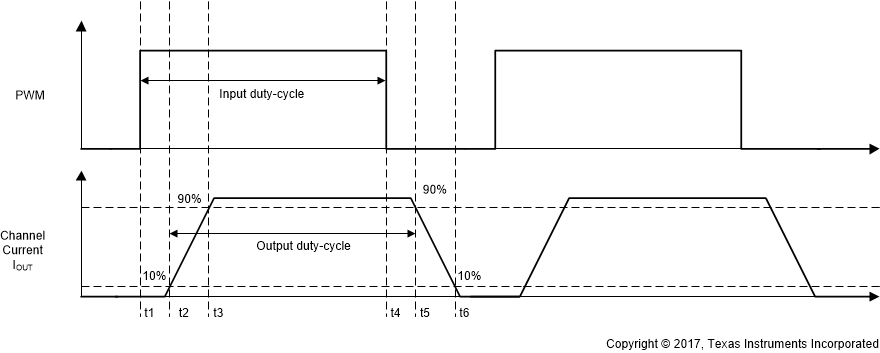SLDS238B January 2018 – January 2020 TPS92611-Q1
PRODUCTION DATA.
- 1 Features
- 2 Applications
- 3 Description
- 4 Revision History
- 5 Pin Configuration and Functions
- 6 Specifications
- 7 Detailed Description
- 8 Application and Implementation
- 9 Power Supply Recommendations
- 10Layout
- 11Device and Documentation Support
- 12Mechanical, Packaging, and Orderable Information
Package Options
Mechanical Data (Package|Pins)
- DGN|8
Thermal pad, mechanical data (Package|Pins)
- DGN|8
Orderable Information
6.6 Timing Requirements
| MIN | NOM | MAX | UNIT | ||
|---|---|---|---|---|---|
| t(PWM_delay_rising) | PWM rising edge delay, 50% PWM voltage to 10% of output current, t2 – t1 as shown in Figure 1 | 17 | µs | ||
| t(PWM_delay_falling) | PWM falling edge delay, 50% PWM voltage to 90% of output current, t5 – t4 as shown in Figure 1 | 21 | µs | ||
| t(TSD_deg) | Thermal overtemperature deglitch timer | 60 | µs | ||
| t(DEVICE_STARTUP) | EN rising edge to 10% output current at 150-mA set current and 12-V supply voltage | 100 | 150 | µs | |
| t(OPEN_deg) | LED open-circuit fault-deglitch time | 80 | 125 | 175 | µs |
| t(SG_deg) | Channel-output short-to-ground detection deglitch time | 80 | 125 | 175 | µs |
| t(Recover_deg) | Recovery deglitch time | 16 | µs | ||
 Figure 1. Output Timing Diagram
Figure 1. Output Timing Diagram